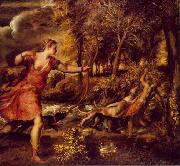
|
Artists
Index
|
||
|
Titian
|
||
|
The Rape of Europa is a bold diagonal composition which was admired and copied by Rubens. new21/Titian-858765.jpg Painting ID:: 61138 |
The Rape of Europa (1562) is a bold diagonal composition which was admired and copied by Rubens. In contrast to the clarity of Titian's early works, it is almost baroque in its blurred lines, swirling colors, and vibrant brushstrokes. | |
| |
|
|
|
|
||
|
The Death of Actaeon. new21/Titian-964547.jpg Painting ID:: 61144 |
The Death of Actaeon. In Titian's later works, the forms lose their solidity and melt into the lush texture of shady, shimmering colors and unsettling atmospheric effects. In addition to energetic brushwork, Titian was said to put paint on with his fingers toward the completion of a painting. | |
| |
|
|
|
|
||
|
Like so many of his late works, new21/Titian-755292.jpg Painting ID:: 61159 |
Like so many of his late works, Titian's last painting, the Piet??, is a dramatic scene of suffering in a nocturnal setting. It was apparently intended for his own tomb chapel. | |
| |
|
|
|
|
||
|
The Allegory of Age Governed by Prudence is thought to depict Titian, new21/Titian-379278.jpg Painting ID:: 61160 |
The Allegory of Age Governed by Prudence (c. 1565?C1570) is thought to depict Titian, his son Orazio, and a young cousin, Marco Vecellio. | |
| |
|
|
|
|
||
|
The Flaying of Marsyas, little known until recent decades new21/Titian-933989.jpg Painting ID:: 61161 |
The Flaying of Marsyas, little known until recent decades | |
| |
|
|
|
|
||
| Prev artist | ||
|
Also Buy::. For Following Paintings / Artists / Products, Please Use Our Search Online: |











